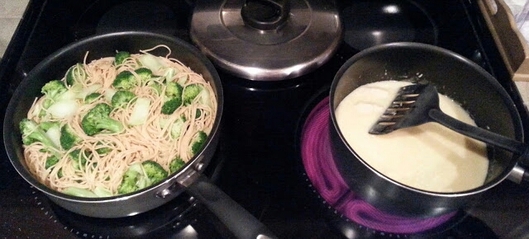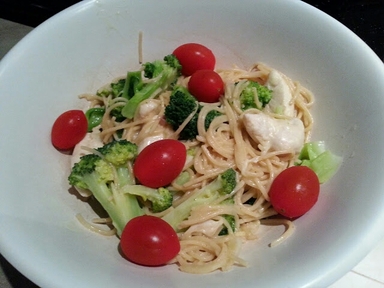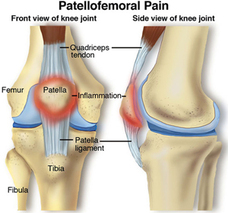After a hard workout, you need to refuel your body. The general myth out there is to refuel on lots of protein, however according to research, your post-workout meal should be mostly rich in carbohydrates to replenish your energy reserves, and combined with a little protein to repair and rebuild muscle fibers. It shouldn't be the other way around. To that end, I tried the recipe below from scratch:
| Original recipe 8 oz of fettuccine or other pasta 10 oz of broccoli 8 oz of chicken breast 10 oz of condensed cream of chicken soup 1 to 3 teaspoons of olive oil 1/2 cup of milk 1/2 cup of grated parmesan cheese | Healthy Substitutions Whole wheat spaghetti Fresh broccoli instead of frozen Low-sodium condensed cream Almond milk with no fat and more calcium |
Nutrition information: 3 servings. 1600 calories total, 533 calories per serving; 70g carbohydrates, 36g protein, and 12g fat per serving
(Courtesy of Suzie Dorner)
(Courtesy of Suzie Dorner)
- After the spaghetti boiled for a few minutes, I added the broccoli for the last couple minutes. I also added the stalk of the broccoli which adds some crunchiness to the dish.
- On the other side of the stove, I cooked the chicken, and added the cream, milk, and cheese to the pan. Just to give it more flavor, I chopped up some garlic and added it to the sauce.
- On the other side of the stove, I cooked the chicken, and added the cream, milk, and cheese to the pan. Just to give it more flavor, I chopped up some garlic and added it to the sauce.
And voila, a dish easy enough to make that will fuel your muscles to get you ready for the next workout! To add some color and nutrients to the meal, I added tomatoes. I wish I had added more milk and cheese to make it creamier, but in all, I was pleased with the results.
By the way, although the substitutions didn't affect the total calorie count by much, it is more satisfying to know that I am consuming healthier products that have more nutrients.
By the way, although the substitutions didn't affect the total calorie count by much, it is more satisfying to know that I am consuming healthier products that have more nutrients.



 RSS Feed
RSS Feed
